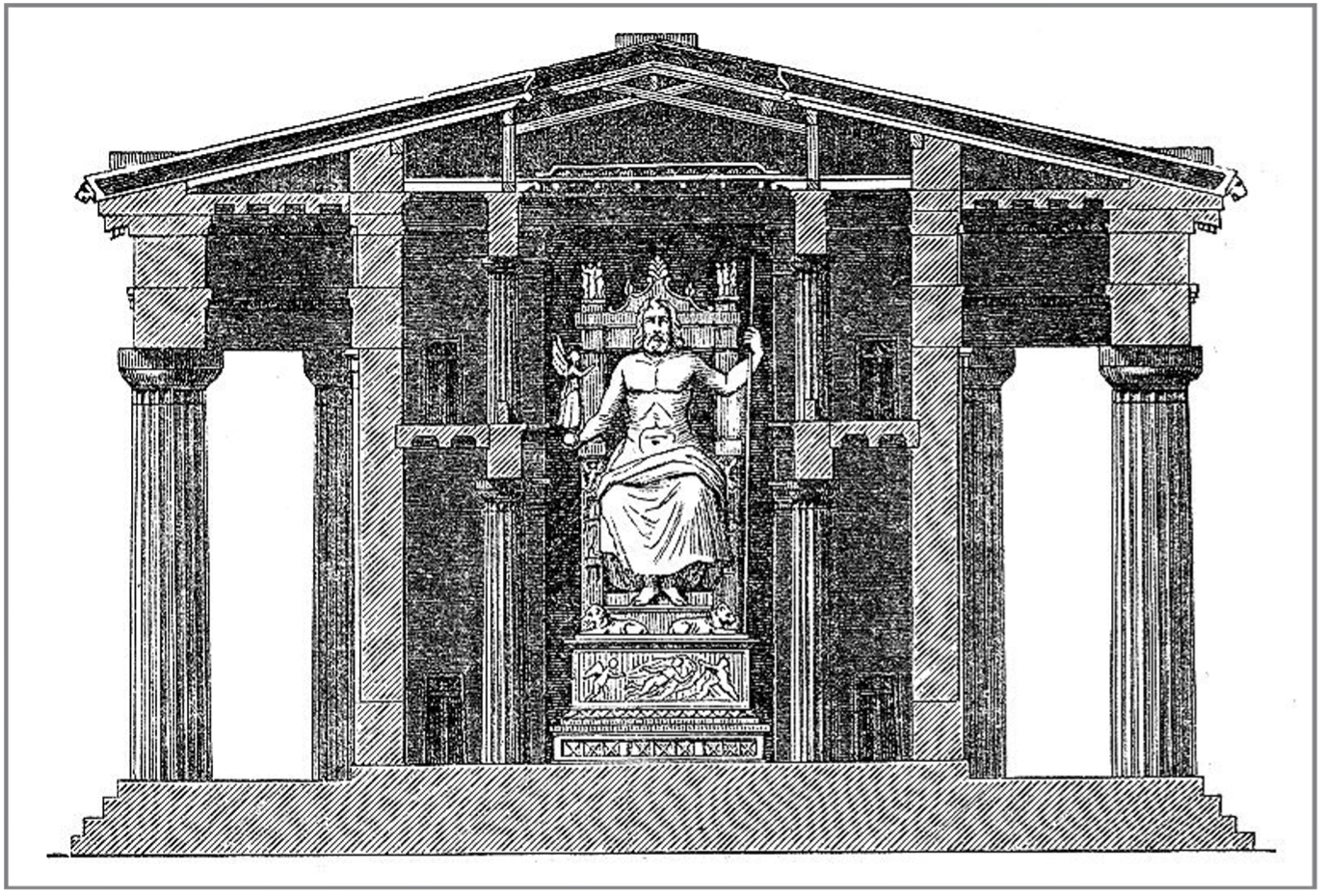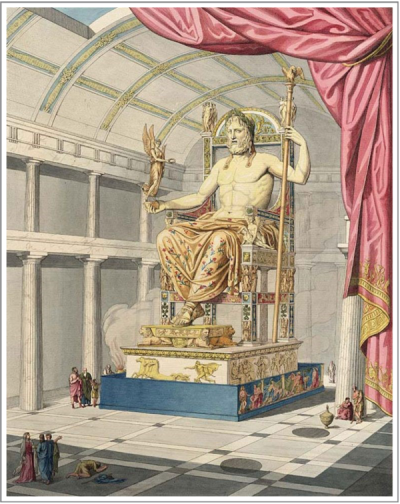by Asia Leonardi for the Carl Kruse Arts Blog
In the northwest of the Peloponnese there is a small village of about 150 inhabitants called Elis, which retains vestiges (even in its modern buildings) of its ancient significance.
The city was once the most important in the region, controlling Olympia, where the Olympic Games were held every four years, in honor of Zeus. The games were organized by Elis, which led to prestige and wealth, despite being more distant than another important city, Pisa, which tried, from time to time, to take over the management of the games, succeeding for short periods.
The city that controlled Olympia, with the attached sacred places, managed the flow of travelers and pilgrims who came on the occasion of the games or to visit the great temple dedicated to Zeus, with its gigantic statue, the work of the great Athenian sculptor/architect Phidias. The statue of Zeus in Olympia, which took about three years of work to complete, probably between 436 and 433 BC, was included in the ranking of the seven wonders of the ancient world.

It was reportedly made of gold and ivory (chryselephantine), a terrific representation of Zeus, to which pilgrims came from all over the Mediterranean to pay homage, and then imitated in subsequent representations of the god both in Greek and Roman art, even reproduced on coins and pottery. For about eight hundred years the magnificent statue amazed those who came to Olympia for reasons of worship or to watch the games.
When Phidias was called to Olympia to make the largest statue in honor of a god, he was already well-known for having supervised the construction of the Parthenon in Athens and for the creation the gigantic statue of the patron goddess of the city, Athena.
In Olympia the temple dedicated to Zeus soon became the best-known place of worship in the ancient world. Imposing in its dimensions (64.2 x24.6 meters x 20 high), the sanctuary is rich in sculptural decorations, in pediments and metopes, which perhaps are the work of a single artist, whose name has not been passed down. The scenes are inspired by various myths: the twelve labors of Hercules, the race with the chariots of Pelops and Oinomaos, a battle between centaurs, and include a majestic statue of Apollo.
After the inauguration of the statue of Athena Parthènos, Phidias was the artist chosen to create the work that would surpass any other of its kind in grandeur. The sculptor moved to Olympia, where a laboratory was made available to him, of which archaeological evidence remains, even a cup (or perhaps a wine jug) with the inscription “I belong to Phidias”. In the laboratory were found some ivory tools, awls, hammers, and lead sheets, as well as the terracotta matrices used to model the gold sheets of which the robe was made, adorned with drawings of lilies in glass paste and stones.

The statue of the divinity, kept in the cell, represented for the Greeks the heart of the sanctuary. When the doors of the temple were opened, the god (or goddess) appears to the faithful . From this central position, it can attend the ceremonies in its honor and appreciate the offerings of the faithful.
It is difficult to imagine the effect that the large statue of Zeus, 12 meters high, with the god seated on a majestic throne would have: the warm white of ivory and the sparkle of gold probably left the faithful speechless, who certainly could not help feel the power of the divine representation.
Phidias creates a chryselephantine statue: ivory, used for the body and face of Zeus, and hammered gold foils for the robe, scepter and parts of the Nike (victory), straight from the right hand of the god. Other materials, such as silver, copper, glass paste, ebony are used for the decorative details and also for the precious throne, adorned with relief figures from mythology (Achilles, the Amazons, Theseus) and history (the battle of Salamis).

The whole composition — Zeus, the throne and the footstool — rests on a black marble base, decorated with scenes from the birth of Aphrodite, which bears the artist’s signature: “Phidias, son of Charmis, an Athenian, He made me”.
Of that wonderful work, known throughout the ancient world, only the literary descriptions remain, such as that of the Greek geographer Pausanias:
“The god, made of gold and ivory, is seated on the throne. On his head is a crown worked in the shape of olive branches. In his right hand he holds a Nike, also a chryselephantine, with a bandage and, on his head, a crown. In the left hand of the god is a scepter adorned with all kinds of metal, and the bird that rests on the scepter is the eagle. The shoes of the god are also golden and so is the mantle. Figurines of animals and lily flowers are embroidered on the mantle. ”

The statue remained in its place for about eight hundred years, even if the Roman emperor Caligula, at the beginning of the first century AD, did everything to bring it to Rome, without success. According to Suetonius, a thunderous laugh froze the workers who were tasked with removing the statue, who then fell from the scaffolding around the statue and gave up the undertaking. Over the centuries, individuals and city-states offered their gifts to Zeus, which made Olympia rich, not only in economic terms, but also in art and culture.
All this ends with the Roman emperor Theodosius I (347-395 CE), who banned pagan worship practices, including the Olympics. In 393 CE, the last Panhellenic games are played, after about a millennium of tradition, for a total of 293 competitions.
The sanctuary fell into disrepair and was then set on fire, by order of Theodosius II, who in 435 AD ordered the destruction of all pagan temples still standing.
The statue of Zeus follows a different fate, although not certain: perhaps it is brought to Constantinople by a high Byzantine official, Lauso, who keeps it in his palace along with many other pagan works of art. In 475 a fire devoured that building along with the entire collection.
Other sources speak of an earthquake or tsunami that destroyed the place where the statue was kept, perhaps in the fifth or sixth century AD.
It is worthwhile, as a closing note, to tell what happened to the great Phidias.
The sculptor was the greatest exponent of classical Greek art, the one that best expressed the cultural and aesthetic ideal of the age of Pericles. Although his works are known mostly through copies or literary descriptions, no one has ever doubted the fundamental importance of Phidias in the history of Greek art.
Alas, while alive he was subjected to personal attacks, intended to discredit Pericles. Some say that Phidias stole part of the gold destined for the chryselephantine statue of Athena Parthènos, but the accusation is unfounded: the sculptor himself had the gold sheets disassembled and weighed, which corresponded to the exact quantity received. Since he was not a thief, another accusation must be found: impiety. How did the sculptor dare to portray himself and his friend Pericles on the shield of the goddess Athena?
He ends up in prison in Athens, where he dies after about a year, perhaps of illness or perhaps poisoned. According to other sources, he escaped, or was exiled, to Olympia, where he died. However, his fame and his name live on. Perhaps he too would be amazed to know that, 2,500 years later, we still talk about his greatness.
============
The Carl Kruse Arts Blog homepage.
Contact: carl AT carlkruse DOT com
Other articles by Asia Leonardi include: The Story of Klimt’s Muse, the San Berillo District in Sicily, and Bowie’s Alter Ego.
Find Carl Kruse also on Pinterest.

I always did wonder what happened to that statueof Zeus.